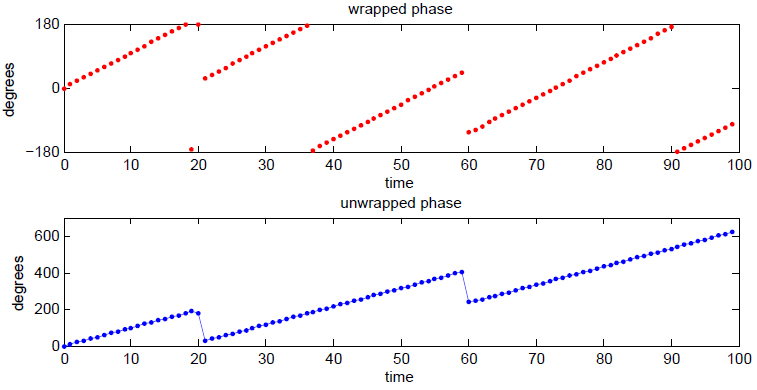Instantaneous frequency on:
[Wikipedia]
[Google]
[Amazon]
Instantaneous phase and frequency are important concepts in 
signal processing
Signal processing is an electrical engineering subfield that focuses on analyzing, modifying and synthesizing '' signals'', such as sound, images, and scientific measurements. Signal processing techniques are used to optimize transmissions, ...
that occur in the context of the representation and analysis of time-varying functions. The instantaneous phase (also known as local phase or simply phase) of a ''complex-valued'' function ''s''(''t''), is the real-valued function:
:
where arg is the complex argument function.
The instantaneous frequency is the temporal rate of change of the instantaneous phase.
And for a ''real-valued'' function ''s''(''t''), it is determined from the function's analytic representation, ''s''a(''t''):
:
where represents the Hilbert transform
In mathematics and in signal processing, the Hilbert transform is a specific linear operator that takes a function, of a real variable and produces another function of a real variable . This linear operator is given by convolution with the functi ...
of ''s''(''t'').
When ''φ''(''t'') is constrained to its principal value
In mathematics, specifically complex analysis, the principal values of a multivalued function are the values along one chosen branch of that function, so that it is single-valued. The simplest case arises in taking the square root of a posit ...
, either the interval or , it is called ''wrapped phase''. Otherwise it is called ''unwrapped phase'', which is a continuous function of argument ''t'', assuming ''s''a(''t'') is a continuous function of ''t''. Unless otherwise indicated, the continuous form should be inferred.

Examples
Example 1
: where ''ω'' > 0. : In this simple sinusoidal example, the constant ''θ'' is also commonly referred to as ''phase'' or ''phase offset''. ''φ''(''t'') is a function of time; ''θ'' is not. In the next example, we also see that the phase offset of a real-valued sinusoid is ambiguous unless a reference (sin or cos) is specified. ''φ''(''t'') is unambiguously defined.Example 2
: where ''ω'' > 0. : In both examples the local maxima of ''s''(''t'') correspond to ''φ''(''t'') = 2''N'' for integer values of ''N''. This has applications in the field of computer vision.Instantaneous frequency
Instantaneous angular frequency is defined as: : and instantaneous (ordinary) frequency is defined as: : where ''φ''(''t'') must be the unwrapped phase; otherwise, if ''φ''(''t'') is wrapped, discontinuities in ''φ''(''t'') will result inDirac delta
In mathematics, the Dirac delta distribution ( distribution), also known as the unit impulse, is a generalized function or distribution (mathematics), distribution over the real numbers, whose value is zero everywhere except at zero, and who ...
impulses in ''f''(''t'').
The inverse operation, which always unwraps phase, is:
:
This instantaneous frequency, ''ω''(''t''), can be derived directly from the real and imaginary parts
In mathematics, a complex number is an element of a number system that extends the real numbers with a specific element denoted , called the imaginary unit and satisfying the equation i^= -1; every complex number can be expressed in the form a ...
of ''s''a(''t''), instead of the complex arg without concern of phase unwrapping.
:
2''m''1 and ''m''2 are the integer multiples of necessary to add to unwrap the phase. At values of time, ''t'', where there is no change to integer ''m''2, the derivative of ''φ''(''t'') is
:
For discrete-time functions, this can be written as a recursion:
:
Discontinuities can then be removed by adding 2 whenever Δ''φ'' 'n''≤ −, and subtracting 2 whenever Δ''φ'' 'n''nbsp;> . That allows ''φ'' 'n''to accumulate without limit and produces an unwrapped instantaneous phase. An equivalent formulation that replaces the modulo 2 operation with a complex multiplication is:
:
where the asterisk denotes complex conjugate. The discrete-time instantaneous frequency (in units of radians per sample) is simply the advancement of phase for that sample
:
Complex representation
In some applications, such as averaging the values of phase at several moments of time, it may be useful to convert each value to a complex number, or vector representation: : This representation is similar to the wrapped phase representation in that it does not distinguish between multiples of 2 in the phase, but similar to the unwrapped phase representation since it is continuous. A vector-average phase can be obtained as the arg of the sum of the complex numbers without concern about wrap-around.See also
*Analytic signal
In mathematics and signal processing, an analytic signal is a complex-valued function that has no negative frequency components. The real and imaginary parts of an analytic signal are real-valued functions related to each other by the Hil ...
*Frequency modulation
Frequency modulation (FM) is the encoding of information in a carrier wave by varying the instantaneous frequency of the wave. The technology is used in telecommunications, radio broadcasting, signal processing, and computing.
In analog ...
*Group delay
In signal processing, group delay and phase delay are delay times experienced by a signal's various frequency components when the signal passes through a system that is linear time-invariant (LTI), such as a microphone, coaxial cable, amplifier, ...
*Instantaneous amplitude
In physics and engineering, the envelope of an oscillating signal is a smooth curve outlining its extremes. The envelope thus generalizes the concept of a constant amplitude into an instantaneous amplitude. The figure illustrates a modulated sine ...
*Negative frequency The concept of signed frequency (negative and positive frequency) can indicate both the rate and sense of rotation; it can be as simple as a wheel rotating clockwise or counterclockwise.
The rate is expressed in units such as revolutions (a.k.a. ''c ...
References
Further reading
* *{{cite book , last1=Granlund , last2=Knutsson , title=Signal Processing for Computer Vision , publisher=Kluwer Academic Publishers , year=1995 Signal processing Digital signal processing Time–frequency analysis Fourier analysis Electrical engineering Audio engineering